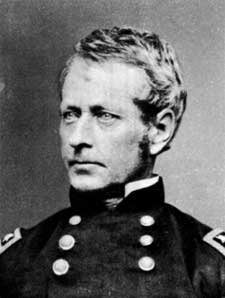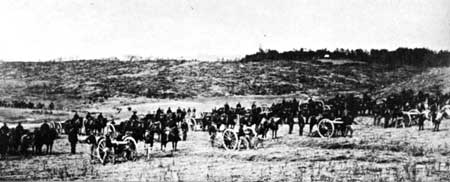|
ANTIETAM National Military Site |
 |
 Brig. Gen. John B. Hood. |
 Maj. Gen. Joseph Hooker. From photograph by Brady or assistant. Courtesy, Library of Congress. |
The Lines Are
Poised for Action
At 2 p.m. on the 16th, Hooker marched from his camp near Keedysville, crossed the Upper Bridge, and late in the afternoon reached the Hagerstown Pike. Under cover of the North Woods, his divisions formed for the attack on both sides of the pike. A massed force of more than 12,000 men was ready to advance on the Confederates.
Lee's thin line, 3 miles long, had been reinforced early on the 16th by the arrival of Jackson's troops from Harpers Ferry. They were placed where they could support the northern part of the Confederate line. John Walker's division, arriving from Harpers Ferry in the afternoon, took position south of Sharpsburg.
Jackson now commanded the Confederate front north of Sharpsburg; Longstreet, with a part of his force north of the village, extended the line nearly a mile south.

Union artillery in battery line.
From 1863 photograph.
Courtesy, Library of Congress.
When Lee's outposts near Antietam Creek informed him in mid-afternoon that Hooker's Federals were massing north of Sharpsburg, Lee moved some of his men to advance positions. Hood established a line east of the Hagerstown Pike, with part of his troops in a cornfield and others extending the front to the East Woods. Skirmishers spread out far in front. Additional troops were rushed from reserve near Lee's headquarters at the Oak Grove west of Sharpsburg; they extended the line west across the Hagerstown Pike.
It was dusk by the time Hooker's force was ready to charge. With Maj. Gen. George Meade's men leading the way, they struck Hood's Confederates at the edge of the East Woods and in the adjacent fields. A brisk artillery fire from opposing batteries forced the men to seek cover. The gathering darkness made it difficult for the forces on either side to locate their marks. Gradually the opening skirmish at Antietam ended. The thrust of the Federal skirmishers, however, made it clear to Lee just where the next Federal blow would fall.
Even as Hooker's Federals withdrew to the cover of the North Woods, strong forces were moving to their aid—the two powerful corps under Mansfield and Sumner. Mansfield would lead the XII Corps across Antietam Creek about midnight and encamp 1/2 miles northeast of Hooker. Sumner's II Corps would cross the Antietam at Pry's Mill Ford at 7:30 the next morning to lend additional support.
Lee, too, was counting on reinforcements. McLaws' division was expected to arrive on the field by midmorning. A. P. Hill, who had been left at Harpers Ferry to handle details of the surrender, would arrive late in the day.
On the evening of September 16, picket lines were so close that the men on both sides, though unable to see each other, could hear footsteps. They knew that a tremendous struggle would begin at dawn. Some tried to sleep, but scattered firing throughout the night made this difficult. Others cleaned and cleaned again their rifled muskets, whose huge bullets made holes as big as silver dollars. Artillerists brought up ammunition for their smooth-bore Napoleons—so deadly at close range—and for the long-range rifled Parrott guns. And so these men got through the night, each one facing the impending crisis in his own way.

Union signal station on Elk Ridge. From here,
McClellan's observers spotted Confederate troop movements during the
battle.
Courtesy, National Archives.

|

|
|
Last Modified: Mon, Mar 4 2002 10:00:00 pm PDT |


